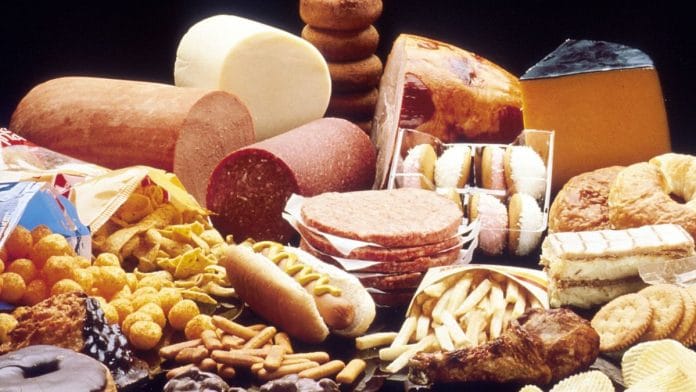New Delhi: Foods such as cakes, chips, cookies, crackers, fried foods, mayonnaise, margarine and ultra-processed foods—which are rich in advanced glycation end products (AGEs)—are a leading cause behind India being the world’s diabetic capital, a first-of-its-kind clinical trial has found.
AGEs are reactive and potentially toxic compounds formed when proteins or lipids are glycated, or modified by aldose sugars, which are carbohydrates with an aldehyde group (CHO).
The government-funded trial—conducted by researchers from various institutions including the Indian Council of Medical Research (ICMR) and Madras Diabetes Research Foundation (MDRF) in Chennai—has shown that consumption of AGE-rich foods leads to inflammation in the body, an underlying cause of diabetes.
This is because glycation—a non-enzymatic chemical process in which a sugar molecule binds to a protein or lipid molecule—can result in harmful reactions in the body, the study said.
The findings of the study, funded by the Department of Biology, were published Thursday in the International Journal of Food Sciences and Nutrition.
By following a low-AGE diet—which includes foods low in AGEs, such as fruits, vegetables, whole grains, and low-fat milk—overweight and obese individuals can reduce oxidative stress in their bodies, which refers to the imbalance of free radicals and antioxidants that results in inflammation and cell damage.
“This dietary intervention has the potential to mitigate the burden of obesity-linked type 2 diabetes,” the researchers noted in the paper.
Understanding AGE-rich foods and what processes cause them to have high amounts of AGEs can be crucial to India’s strategy in fighting diabetes, Dr. V. Mohan, chairman, MDRF, and one of the authors on the paper, told ThePrint.
A study by the ICMR and MDRF—published in June 2023 in the journal The Lancet Diabetes & Endocrinology, and which was based on surveys conducted between 2008 and 2020 in 31 states and Union Territories—showed that the prevalence of diabetes in India in 2021 was a whopping 11.4 percent. In other words, an estimated 10.1 crore Indians were found to be diabetic in 2021.
Also Read: This experimental lung cancer drug outperforms blockbuster medicine Keytruda. But there’s a catch
What the study found
Previous studies from the West have demonstrated an increased risk for chronic diseases due to the consumption of highly processed foods rich in fat, sugar, salt, and AGEs.
The rapid nutrition transition that has occurred in developing countries such as India, has led to higher intakes of refined carbohydrates, fats, and animal products, researchers say, adding that such food habits, combined with a sedentary lifestyle, further increase the prevalence of obesity, diabetes, and associated disorders.
However, there had been a dearth of data on AGEs in Indian diets, and their effects on cardiometabolic markers or indicators of cardiovascular and metabolic diseases.
Such data, the study said, are valuable as Indians are more prone to insulin resistance (a condition in which cells in the muscles and liver do not respond to insulin, a hormone produced by the pancreas, as a result of which the cells cannot take up glucose), type 2 diabetes (high blood sugar levels as a result of insulin resistance) and cardiovascular diseases.
Therefore, the new study investigated the effects of low- and high-AGE diets on glucose and lipid metabolism, oxidative stress, and inflammation, in overweight and obese Indian adults.
As part of the clinical trial, as many as 38 adults—either overweight (those with a body mass index (BMI) of 25 or higher, but less than 30) or obese (those with a BMI of 30 or higher) but non-diabetic—were divided into two groups.
One group was given a low-AGE diet for 12 weeks, while the other a high-AGE diet over the same period.
The dietary AGE content varies depending on the method of cooking. Hence, varieties of foods—prepared using multiple cooking methods such as stir-frying, deep-frying, steaming, boiling, pressure cooking, and baking—were given to the participants.
The diets planned were categorised as low- and high-AGE, based on the culture-specific food habits of Indian adults, and matched for calories and macronutrient composition.
The high-AGE foods included those prepared by roasting, deep-frying, and shallow-frying, while the low-AGE foods included those cooked by boiling and steaming, in a short span of time.
At the end of 12 weeks, the researchers found that the insulin oral disposition index—a measure of insulin sensitivity, and how well pancreatic beta cells, which produce insulin, function—was significantly increased in the low-AGE diet group, compared to the high-AGE diet group.
Insulin sensitivity refers to how well cells respond to insulin for glucose uptake from the blood.
The low-AGE diet group also showed a significant reduction in 30-minute postload plasma glucose (PG) levels—which can be used to predict the risk of future type 2 diabetes—compared to the high-AGE diet group.
Significance of the study
The study included culture-specific, commonly consumed Indian foods in the diets of the groups. These foods were measured for dietary AGE composition before planning the intervention diet menu.
Dr. Mohan explained that the findings establish—through evidence in the Indian context—that healthy foods, such as fruits, vegetables, green leafy vegetables and whole grains, and items that are not processed, have low AGE.
“Also, if you boil the food and don’t fry, grill or roast it, or add a lot of oil, ghee or other lipids to it, you can keep the dietary AGE low,” he said.
In general, fried, grilled and baked foods have the highest AGE levels. Other high-AGE foods include dry nuts, roasted walnuts, sunflower seeds, fried chicken, bacon, and beef. In addition, animal proteins and processed plant foods contain molecules that make them prone to glycation, the study authors have said.
(Edited by Radifah Kabir)
Also Read: What Centre’s new draft norms on passive euthanasia say & why doctors are divided over the move







For Asians, BMI of 23 or more is the cut off for being overturns overweight. Read thoroughly about ghee and decide yourself whether to eat it or not